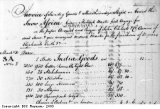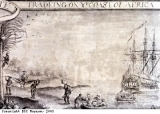The value of trade
European ships’ captains used the ‘trade ounce’, or ‘bar’, to buy slaves. The slave traders did not use pounds, shillings and pence. The cost of the trade goods in pounds was translated into a value in ‘bars’. The bar was an imaginary device for valuing the items. The bar itself had a certain value, which was based on the price of a bar of iron. So all the trade goods had a trade value in bars, as well as a real value in pounds, shillings and pence. A slave’s price would be agreed at so many bars. A mixture of trade goods whose value in bars was the same as the agreed value of the slave would be given in exchange. One Bristol captain in the 1780s paid a trader, who was known as ‘King Peppel’, 85 bars for one male slave, plus 50 bars as a ‘sweetener’ to get in the African trader’s good books. Payment was made in cloth, guns, gunpowder, brassware, iron and beads, which came to the value of 135 bars. This would have been equivalent to about £25 (about £1200 today). The accounts book for the first voyage of the ship the Africa in 1774 is pictured here. It lists some of the trade goods taken to Africa and their values. The guns, gunpowder, lead shot and gunflints are all listed. Their value is given in pounds (sterling) and in ‘bars’, the unit of currency used in the slave trade. The cargo was valued at £4,648 (about £232,000 today) or 24,220 bars.
The trade goods were often cheap, but African traders had definite ideas about what they required. European traders could be left with unsaleable cargoes and few slaves, if they had trade goods that the African traders did not want. Beads were a small part of a trade cargo. All the cargo had to be recorded and documented as it was loaded. The receipt shown here for three casks of beads records that they were loaded onto a ship “by God’s Grace bound for Africa”. Slavers usually carried many different types of bead, ranging from tiny ‘seed’ beads to big ‘chevrons’. They were not always quite the beads that the African traders wanted. The ship the Africa in 1774 was left with a large stock of unsold beads. The European traders could be caught out by a change in fashion, and find that the beads they had on board were not the right size or shape or colour.
Ships’ captains often gave African traders goods in advance for slaves. The African traders had to arrange to buy slaves with the goods, from further inland, away from the coast. Until they produced the slaves, they were forced to leave someone as hostage with the ship’s captain. The hostage was usually someone from the trader’s family or community. The captains demanded that a hostage be left, in case the African traders ran away with the goods without supplying any slaves in return. Trust between European captains and African traders was a fragile thing. Captain Joseph Williams of the Bristol ship the Ruby dealt with traders from Cameroon, West Africa in 1787. These traders were known to the Europeans as King George, King Peter, Quon and King Mason. Williams gave the traders goods with which to buy slaves. The Cameroon traders had to leave relatives on the ship as hostage for the goods they had. These hostages were known as “pawns‘. If the traders did not return with the slaves Williams would have taken the pawns as slaves.
This detail of a drawing of the slave ship the Southwell Frigate shows trade goods being brought ashore. The goods will then be exchanged, by the ships captain, with the African traders for slaves.
European and African traders had to have partnerships, as they relied on each other for their business. The European traders needed their African trading partner to bring them enslaved Africans. The slaves would be shipped across the Atlantic Ocean to the plantations in the Caribbean and Americas. The African traders exchanged enslaved people for goods such as beads and cloth, which they could then sell to fellow Africans, or use to enhance their own status and position.





